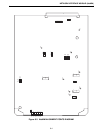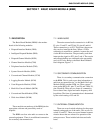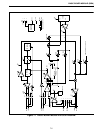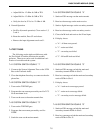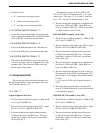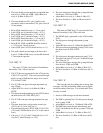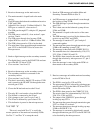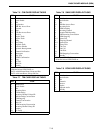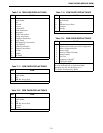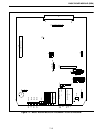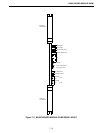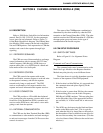
BASIC BOARD MODULE (BBM)
7-8
2. Receives the message on the main receive.
• The main transmit is looped back to the main
receive.
• The FSK enters the balanced to unbalanced receiver
U28C and U28D.
• Adjust R41 for a level of -21 dBm ±1 dB at J11. The
FSK goes to switch S1, close section 3.
• The FSK goes through J27 with pins 2/3 jumpered
together.
• The FSK goes to switch S1, close section 2, open
sections 1 and 4.
• The FSK passes through level op amp U34B.
• Adjust R102 for a level of -12 dBm ±1 dB at TP8.
• The FSK is then passed to U16 to be decoded.
• The serial data is then passed through transmission
gate U33C to the DUART U6 to be sent to the
microprocessor.
3. Sends a digital message out the secondary transmit.
• The digital data is sent by the DUART U6 and sent
out of the RS-232 driver U35E.
• Close sections 3 and 4 on S3.
4. Receives the message on the secondary receive.
• The secondary transmit is connected to the
secondary receive.
• Close sections 1 and 2 of S4.
• The data is received by the RS-232 receiver U35D
and is passed to the DUART U6 through the trans-
mission gate U33D.
5. Closes the M-lead and receives the E-lead.
• The relay K1 is activated to close the M-lead.
• The M-lead is connected to the E-lead.
• J36 is jumper to pin 1 and 2 or pin 2 and 3.
• The E-lead is detected by opto isolator U29.
• This indication is passed to the microprocessor.
7.5.5 TEST "5"
This test is used with Test "6" to verify the
correct operation of the main and secondary PCMs.
Use Test "1" and Test "8" to setup the cards.
1. Sends an FSK message on both the Main and
Secondary Transmit PCMs in Slot 31.
• An FSK message is generated and is sent through
the leveling op amp U32B.
• The FSK message is passed through transmission
gate U31C.
• This is then sent out the balanced op amp drivers
U28A and U28B.
• The transmit is looped to the receive of the same
card.
• The FSK message is received by the balanced line
receiver op amp U28C and U28D.
• The message is routed to J27, pin 2 and pin 3
connected together.
• The message then passes through transmission gate
U30B to the summing op amp U32C.
• The message is then sent to the CODEC ID U19.
• The transmit time slot is determined by U26, U22,
U23, U36A, U36B, U20 and U21.
• The PCM is then routed to the main PCM via U25
through the selection by microprocessor U7, pin 5
and Pin 48.
• Once the message is sent via the main PCM it is
then routed to the secondary PCM.
2. Receives a message on both the main and secondary
receive PCMs in Slot 0.
• The PCM is received by U59 and U26.
• The appropriate PCM is selected by selecting trans-
mission gate U27A for the Main PCM and U27D
for the Secondary PCM.
• The PCM is then passed to the CODEC IC U19.
The receive time slot is determined by U26, U55,
U56, U3A, U3B, and U52.
• The output of the CODEC IC passes through
leveling op amp U32A.
• The message then passes through transmission gate
U57C to switch S1, section 4.
• The message then passes through leveling op amp
U34B to the FSK IC U16.
• The message is converted to digital and is passed
through transmission gate U33C to the DUART U6
to be decoded by the microprocessor.



